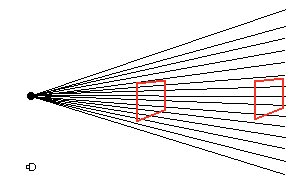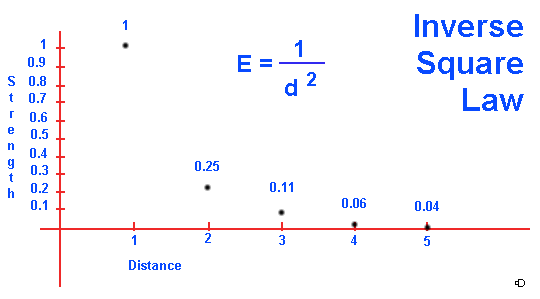

Maths formula also most certain to be used in this area !!!
In this section you must also relate the information that under free space conditions e-m waves travel in straight lines and spread out according to an inverse square law of power flux density (PFD) and that the field strength FS, measured in volts/metre, drops linearly with distance.
In this section of the syllabus you may well have a question that relates to both PFD (power flux density) and or FS (field strength).

Remember this drawing you saw earlier ?
All radio waves are subject to the inverse square law which says that the energy spreads out according to the square of the distance travelled. Thus,

The graph shows that the energy at say 1m is 1 watt/m2
then at 2m 1/d2 = 1 / 2x2 = 0.25
then at 3m 1/d2 = 1 / 3x3 = 0.11
then at 4m 1/d2 = 1 / 4x4 = 0.06
So if a question asks what the power flux from a transmitter at twice the distance from the transmitter the answer is 1/ 2x2 = 0.25 the power level at the transmitter.
6E1 Recall that reducing field strength to the minimum required for effective communication is good radio housekeeping.
The greater the field strength the greater will be the likelihood of causing electromagnetic radiation that can cause problems to electronic equipment that cannot withstand higher levels of electromagnetic radiation. So working at the lowest power level and thus lowest electromagnetic radiation, compatible with acceptable communication level, MUST be the goals of all amateur radio operators what ever mode they are using.
6E1 continued: Apply the formula for field strength surrounding an antenna given the ERP and distance from it.

From the above you can see that d the distance is a unit number and not like the d2 of the PFD mentioned above so double the distance halves the field strength.

So whilst the FS drops linearly that is not a straight line on the graph
From the above you can see that the field strength is not frequency dependent but is related only to the ERP (effective radiated power) of the signal in WATTS and the distance in metres.
Example: If your transmitter has a power out of 100W to an antenna with a 2 times gain what will be your Field strength at 2m in front of the yagi ?
From the equation 7 ( sqrt (2 x 100) )/ 2 = 49.797 V/m Click here for calculator key strokes
Example: If your transmitter has a power output of 100W to an antenna with a 2 times gain what will be your Field strength at 2000m in front of the yagi ?
From the equation 7 ( sqrt (2 x 100) )/ 2000 = 0.049 V/m
By manipulation of the formula we can answer the question :-
Example: What ERP would be required to have a Field Strength of 1.5V/m at 25m ?
The rearranged equation is ![]()
Thus ERP = (1.5 x 25 / 7)2 = 28.69 W (ERP) Click here for calculator key strokes
THE FIELD STRENGTH METER.
By adding a small pickup rod (like a transistor radio aerial) to the tuned circuit of an absorption wavemeter, the meter may be used as a relative field strength meter, useful when checking antenna gain or directivity.
The origin of some of the text on this page is from the RSGB with additions by the web master